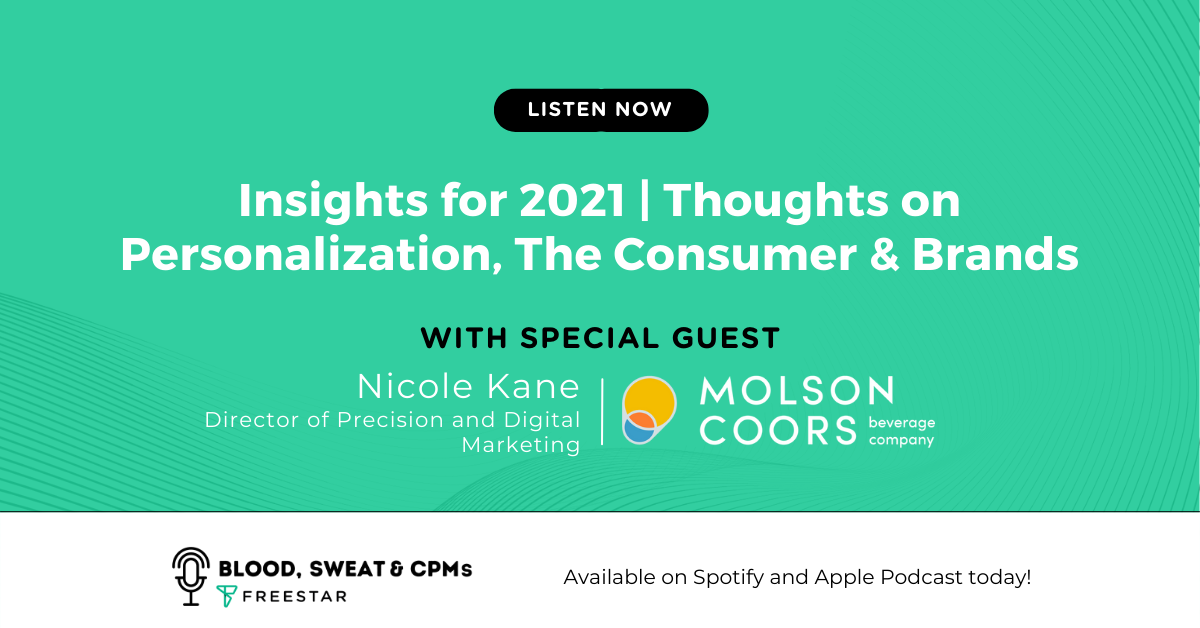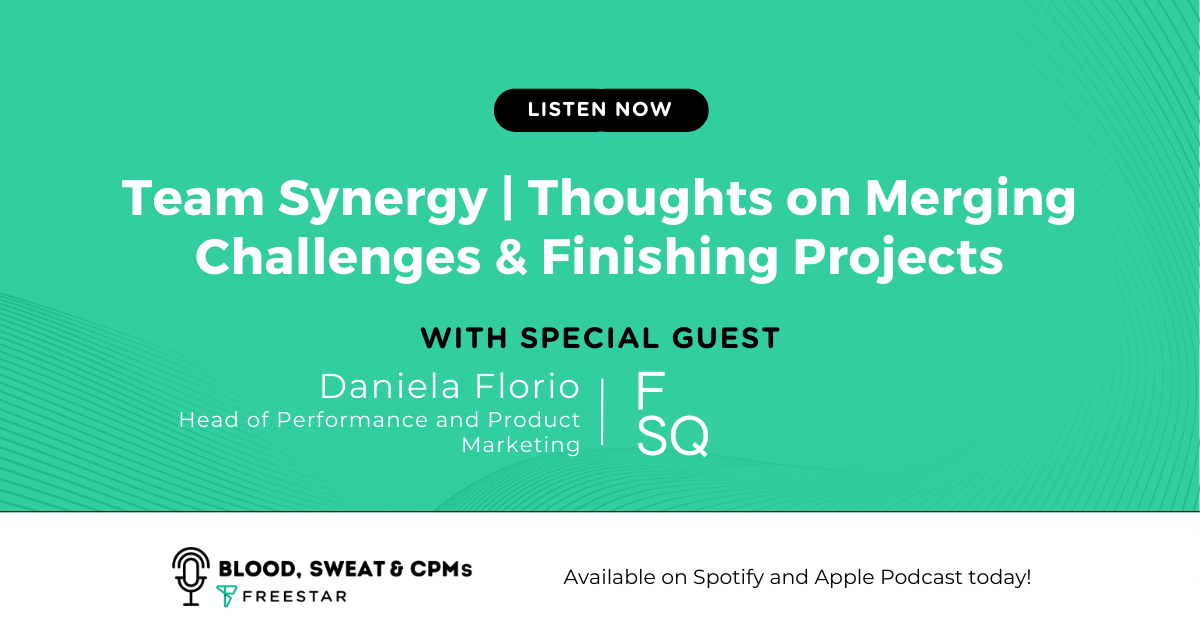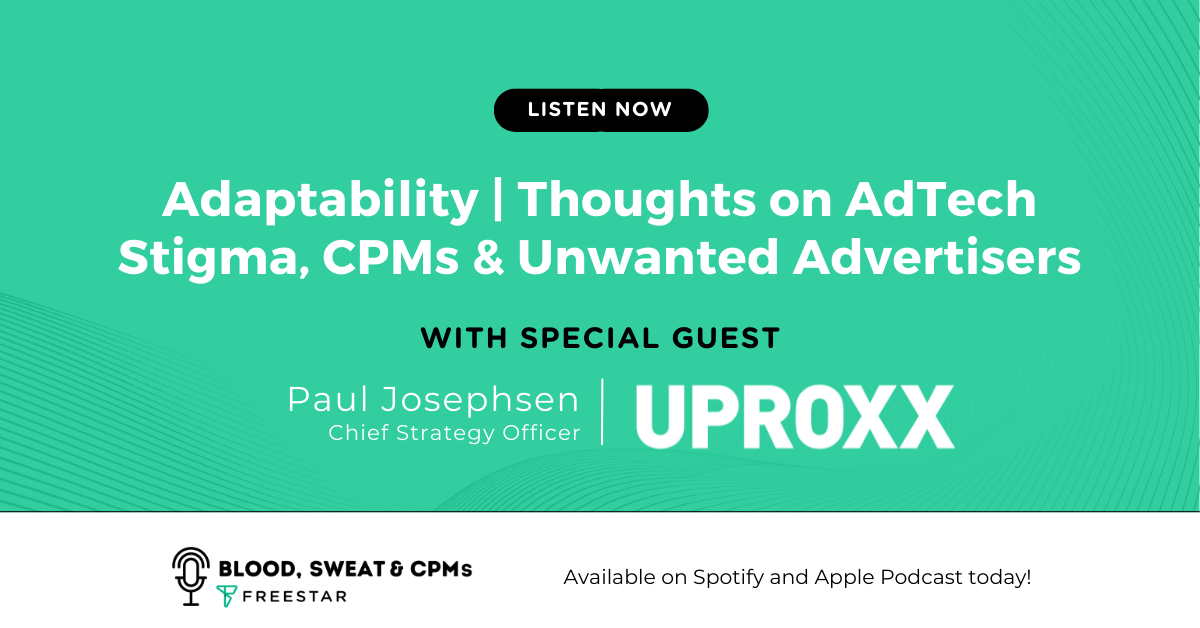Welcome to the Blood, Sweat and CPMs Podcast presented by Freestar.
Our host, Jeff Kudishevich is here to add levity and provide helpful pointers for anyone navigating the world of Ad Tech. Each episode, Jeff will interview thought leaders across the industry to get their perspective on what matters most to them, often times bringing in guest experts from the Freestar team. Follow along on our Blog for show notes and associated links to each episode. Enjoy!
Episode 17
Nicole Kane (Molson Coors) on Insights for 2021 | Thoughts on Personalization, The Consumer & Brands
In this first episode of the new season of our podcast, our host Jeff Kudishevich speaks with Director of Precision and Digital Marketing at Molson Coors, Nicole Kane about key insights for 2021, personalization, and being agile in respect to the consumer and brands.
Listen to the episode on Spotify, now!
About Our Guests
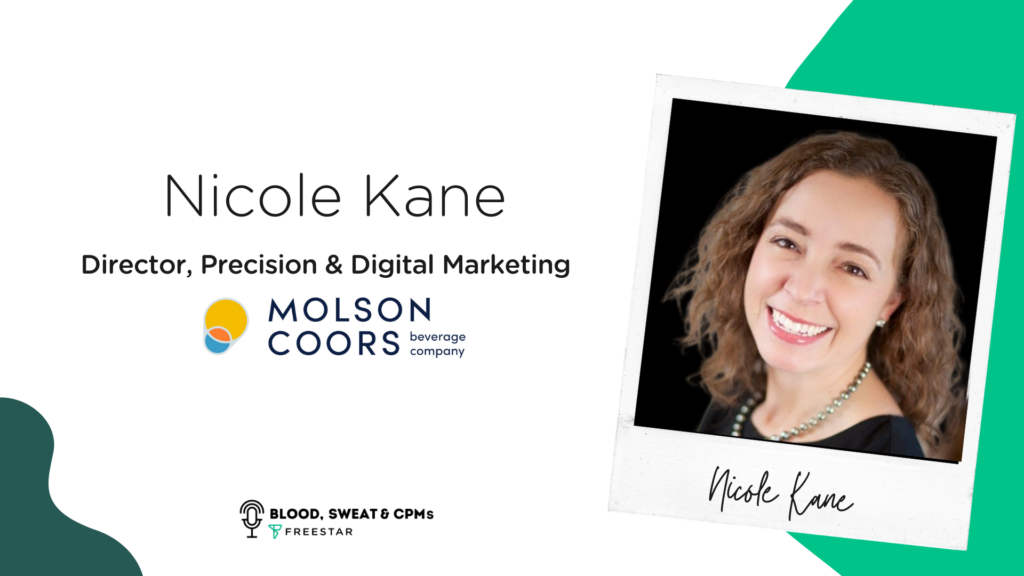
Nicole is the North America Head of Precision & Digital Marketing at Molson Coors. She is responsible for data strategy, precision activation, marketing optimization, and technology solutions for how Molson Coors brands connect with consumers. Before Molson Coors, Nicole was the Head of Media for Hawkeye Agency, the largest pure-play CRM Agency in North America, and the Global Media Director at McDonald’s, overseeing global partnerships, strategy, and agency relationships. In 2014, she forecasted the role data and analytics would play in transforming marketing and went to Civis Analytics to hone her people-based marketing capabilities. An omnichannel strategist inspired by data has also worked at leading media agencies such as OMD and Starcom across B2B, CPG, QSR, Finance, Retail, Technology, and Travel.
Find Nicole on LinkedIn: https://www.linkedin.com/in/nicolenkane/
[00:00:04.335] – Nicole Kane
So I think that’s where the challenge comes into play, is you can have these great innovative ideas, but if you can’t get the company and the culture on board with making those changes and how you connect with your consumer. That’s where you start to face barriers.
[00:00:21.855] – Jeff Kudishevich
Welcome, welcome, welcome.
[00:00:23.805] – Jeff Kudishevich
This is the Freestar presents Blood, Sweat and CPMs podcast. I’m your host, Jeff Kudishevich. I hope everyone had some time to really recharge the batteries with a nice holiday season and hopefully a great New Year’s to boot. Heading into 2021. Things are clearly a lot different with this January, but one thing seems to never change. And that’s our favorite, or not, January CPMs. Gotta hope they’re not too, too brutal for you and your company.
[00:00:54.915] – Jeff Kudishevich
But just remember, either way, they’re going to be picking up soon. During our last company, All Hands. One topic that really stuck out for me were electronic calendars. It seriously blows my mind that there are still some humans on planet Earth who use a paper calendar in their personal life, or worse yet, people who don’t use a calendar at all.
[00:01:25.005]
If this is hitting home for you, listen, there’s nothing else you need to do this year other than convert to an electronic calendar in your personal life. I promise you, this will be a game changer. And I’d like to first welcome you to the rest of your new life. With the New Year. We also have a new season for our podcast. Last year, of course, we launched the show with a blend of kind of timely add ops threads from Reddit and a slew of amazing guests from around the industry.
[00:01:57.825]
I learned a lot. I hope you did, too. After getting some great feedback both here at Freestar and from our listeners, we decided to really just focus on the guest interviews in twenty twenty one. Those seem to be the part of the show that resonated the best. And honestly, I’m very excited for all of the great conversations to come with those changes. Of course, you’re going to be stuck with just me going forward. Don’t worry.
[00:02:24.105]
We’ll have some great guest host pop in from time to time as well. I wanted to thank Andy Forwark for co-hosting the first season of our show. We had a lot of fun and he’s going to be focusing on building our best in class products here at Freestar in his new role. And don’t worry, we’re still going to be ribbing each other every day on Slack. Now, before we hop over to our interview today, I want to mention that we’re hosting an awesome panel around the topic of the Cookie-less world.
[00:02:52.155]
We’ll have some folks from Freestar, Google and an old friend of the podcast, Matthew Hogg of Crideo. The live panel will be airing on January 21st from four to five thirty p.m. Eastern. You can find out information on tuning in at our blog, which is Freestar dot com forward slash blog. Pretty easy. Now on to our awesome conversation with Nicole Cain from Molson Coors.
[00:03:22.655]
Nicole is the North America head of precision and digital marketing at Molson Coors she is responsible for data strategy, precision activation, marketing, optimization and technology solutions for how Molson Coors brands connect with consumers. Before Molson Coors, Nicole was the head of media for Harki Agency, the largest pure play CRM agency in North America, and the global media director at McDonald’s overseeing global partnerships, strategies and agency relationships. In 2014 she forecasted the role that data and analytics would play in transforming marketing and went to Civis Analytics to hone her people based marketing capabilities on omni channel strategies inspired by data has also worked at leading media agencies such as OMD and Starcom across B2B, CPG, QSR, finance, retail, technology and travel.
[00:04:22.535]
All right.
[00:04:23.105]
Now we’re welcoming our special guest, Nicole Cahn from Molson Coors. Nicole, thank you so much for joining us today. Thanks for having me. Awesome.
[00:04:31.325]
So, Nicole, just kind of curious if you could talk us through your transition to Molson Coors, mid pandemic in particular.
[00:04:40.085]
Yeah, I mean, it’s an interesting time starting at a new company in the middle of the pandemic. I started it in June, so they had a little bit under their feet to get used to the pandemic. When I started, they had already figured out how to adjust a lot of their training programs to be virtual and remote. They have a great program that’s welcome coors, a week long program. You know, the kind of that those you don’t get to really meet people.
[00:05:04.115]
So I think for all worth starting now, it’s about how do you build relationships spiritually, especially for someone like myself? I’m in a center of excellence role. So having those relationships and being able to influence to start building the capabilities that I’ve been brought in to do requires those relationships. But I think overall everyone’s figuring it out.
[00:05:24.995]
And hopefully in my first year at the company, I’ll to meet someone in person. Just you sort of mentioned getting to know people. So what have you done or tried or what’s worked to sort of get to know people virtually, I suppose? Yeah.
[00:05:41.795]
I mean, I think you have to go out of your way to schedule one on one time with people. You don’t get the luxury of a casual fly by at someone’s desk or getting to go out to lunch with someone. So I think it’s about creating those purposeful windows of time to really try and get to know each other, but also in those times trying to get to know each other as individuals and as human beings and not just talking about work nonstop.
[00:06:04.475]
Nicole, you’ve worked at client direct and agencies, so how have those worlds differ?
[00:06:09.815]
You know, it’s interesting. I think they are pretty different for the most part. When you’re on the agency side, which I’d say is the bulk of my time, you’re really in client service. So you are doing things for your clients. You are doing the work to make your clients look good, obviously, hopefully if you’re doing your job well, but you’re also logging your hours just as if you’re a lawyer. You’re doing things based on a scope of work that’s in a contract that’s been written.
[00:06:33.035]
And with that, depending on your seniority level, you might be working on one client every single day for a year or so. You might also be juggling five clients at one time and having to juggle new business. So I think it’s a very different pace in a very different lifestyle from that perspective. And I think when you go over to client direct, you truly for the first time become an ambassador of that brand. So before you are representing the brand now, you are a representation of the brand.
[00:07:00.425]
When you are out in a marketing community, when you’re out talking to your friends, think especially in the type of industry that I’m in now, because everyone knows brands and they ask you about it, really are having the opportunity to set visions and do leadership in areas that you have a lot of passion for, especially if you’re doing five five brands at once, like you like you alluded to, right?
[00:07:20.625]
Yeah.
[00:07:21.095]
Then you’re just kind of trying to keep up with everything going on. So one follow up to that.
[00:07:25.475]
Like you mentioned, like by being an ambassador for the brand now being at Molson Coors. So did you have a big buy into the company and they’re in their brand before. And what they mean, obviously, they’re a beer company, but they have many, many different things under their belt. So are you, like, bought in more? We already bought in.
[00:07:44.375]
I would say I was already bought in, I grew up in Chicago, in the Midwest with brands like Miller Lite. So I already had, I’d say, more of an affinity towards some of their products. But I think when you see the inner workings of it and the passion behind some of the brands, what these brands stand for other purposes, you start to get sold and a little bit more as well.
[00:08:02.765]
That totally makes sense. Touching off of that a little bit, Nicole. So Molson Coors, super storied brand. If you don’t if you haven’t heard of it, you’re you’re you’re living in under a rock. Right. So kind of knowing that, you know, the brand is kind of Americana. Right? What kind of challenges do you face just dealing with trying to innovate when the brand is so part of our psyche as as consumers? Right.
[00:08:34.025]
Yeah, you know, I think if you look at most employers as a whole, we’ve had some really great innovation stories in 20, 20, especially on the product side. In 2020, we’ve launched brands such as busy with large brands such as Blue Sky Light brands that are really resonating with consumers. I think when it comes to innovation that most employers in the space in which I operate for precision digital marketing, it’s really about how do we change the internal capabilities and how do we use data and technology and analytics in how we innovate and how we connect with consumers.
[00:09:09.725]
So we’re doing a little bit from the back end. When you think about challenges, and I would think most people at larger, more established brands faced similar challenges are happened over the last few years. Right. It’s about how do we change the ways that we work to be more agile? How do we maybe change some of our processes? How do we start to unify data sets that are sitting out in different silos all over the organization? How do we make sure that our technology stacks our design for modern marketing that is consumer facing?
[00:09:40.385]
Right. How do we start to think about some of those new types of platforms? So I think that’s where the challenge comes into play, is you can have these great innovative ideas, but if you can’t get the company and the culture on board with making those changes and how you connect with your consumer, that’s where you start to face barriers. Cool, also talking about the data and analytics.
[00:10:00.035]
What are the some of the interesting ways that you use data to inform decisions that your team is making?
[00:10:05.825]
Yeah, I mean, one of the main areas that we focus on marketing analytics, for example, as part of my team and one of the things that we look at is multi touch attribution. So how especially in a world like today where consumer behavior is constantly changing, can we understand the output of our marketing campaigns? How can we make sure we’re being able to optimize our creative that’s in market with the channels that are being used and even at a tactical level down to the very programs that we’re running in and make sure we’re getting the best value for every single dollar we put out there.
[00:10:38.975]
And so obviously, it takes a lot of heavy lifting on the analytics and data side to connect all those dots and to start to see those improvements and also to do it in a pretty quick fashion. Today, we are running analysis and waiting a year and picking it up again. We’re doing it a much more frequent cadence to really make sure when things are changing the marketplace, we can be adaptive and improve what we’re doing.
[00:10:59.855]
And you kind of touched on the adaptive piece, Nicole, again, kind of sticking with the large brand. How fast do you sort of see, hey, we’re seeing a trend here or this data is telling us to be in this market? What do you then do there?
[00:11:16.745]
Yeah, so I would say over the last full year, year and a half, the company as a whole, especially in the market group, has really adopted a more what they call fast messianism approach. And it’s really about what are we seeing that’s happening in culture that we need to be fast and quick with. So how are we using tools we have like social listening to see what’s out there? Sometimes you watch it over time, depending on what it is. Sometimes you might see a really great opportunity and just run with it.
[00:11:45.215]
At the start of covid, Coors Light, for example, had a situation where there was literally this ninety three year old woman and there was a picture that went out where she was holding up a coors light like hand in hand held signs, and maybe you had seen it, that basically said I need more beer.
[00:12:03.575]
And the team saw it and they shipped her beer and went totally viral. So you need to actually be actively out there looking for those types of opportunities that you can celebrate and really pay back a loyal fan of yours in those moments. And if you’re just passively sitting back, you are going to find those on your own.
[00:12:22.085]
That that totally makes sense. And kind of leads me to the next thing we wanted to chat about. So we read in a in a recent Adweek article where you were sort of discussing being agile and personalizing the experience with the consumer. I think that’s that’s a great example of that. Can you speak a little bit more to how maybe the company at large or how your team really incorporates those to being agile and really personalizing the experience?
[00:12:49.895]
There’s a lot of research out there today, right. That says consumers are going to be more responsive and receptive to brands to make something a personal experience for them. They’re going to be more likely to actually come back and purchase you or use your service again. So it’s really about how do we take the old mantra of finding the right place at the right moment with the right message to connect with you? Right. It’s about understanding. On one day it might be that you’re sitting outside in beautiful sunny day and that triggers that maybe it’s a day for a beer.
[00:13:21.115]
On the back patio. It could be a situation where you are at the shelf and you can’t find what you want and you want to find the next store that has it right. It could be a situation where there is a certain reason to leave on a product that’s going to convince a loyal drinker, but might not that light drinker. So how do you make sure you’re in the right message to different people as they think about your brand? So there’s not a one size fits all strategy that it really has to do with what your objective is?
[00:13:50.635]
And how do you find those really relevant moments where someone’s can be receptive?
[00:13:54.385]
And I guess how has that shifted in these days? Right, where most of the country people aren’t going to bars are not having necessarily the backyard kickbacks or parties or things like that. So how is that maybe forced change or how have you worked within those confines?
[00:14:16.045]
Yeah, I know it’s a great question. I mean, I think the playbooks that we all used, I guess now 8, 10 months ago don’t necessarily work the same anymore. Signals that we were using data signals like location data. I think location data is great, but not in the middle of a global pandemic, people aren’t leaving their houses. So it’s really about finding what are the signals and what is the new consumer behavior that you need to be seeking out.
[00:14:42.895]
The other piece that I think it’s interesting this time is everything in the United States is happening so differently at different micro geographic levels. So how can you use even location data from that perspective to understand maybe sometimes you don’t always have big national strategy. Sometimes you might need a more localized strategy if behavior is completely different in one area versus another. And I think that’s an area the more brands might start leaning into as we go into 2021, depending on what happens with covid, how it shakes out, how behavior changes now, that that totally makes sense.
[00:15:16.255]
Yeah. So as we go into 2021, can you share some ideas of how you expect the consumer and the Molson Coors relationship to continue to evolve.
[00:15:25.615]
Yeah, I mean I think the relationship will stay strong. I think the consumers will keep seeing us lean in and doing things that they enjoy. I think what we all need to be paying attention to as marketers is what is that evolving change of the consumer? I would be really surprised that there are many brands today that have true full 2021 plans that they’ve locked in, because the reality is we’re all going to keep pivoting. There are a lot of unknowns still out there.
[00:15:53.425]
So for first quarter we might have a good sense what’s going on. I think right now, Q2, no one really knows how the US is going to open up yet. So I think it’s just about mindful, again, about being relevant, being sensitive, what’s going on in the market and hoping that our brands can solve some of the needs that our consumers have.
[00:16:13.435]
Nicole, kind of funny you mentioned maybe we we sort of know what’s going what’s going to happen in Q1. Does it feel sometimes we’re like, hey, let’s just focus on next week and know what we’re doing next week and and not talk about the future too much?
[00:16:28.945]
Yes, definitely. We have a lot of last minute campaigns at launch because of that fact that we’re looking for those opportunities, last minute promotions that go out. There’s definitely those temple events. We have holiday camp running right now because it’s holiday time. So you expect. But other things you are going to do at the last minute, and I don’t think that’s going away any time soon.
[00:16:49.975]
It totally makes sense. I’m just you know, obviously our business has been changing a lot. I can imagine if somebody is trying to think that far ahead or even a quarter ahead and the winds change, so to speak, or things happen with regulation down at the county level or what have you. And now you’ve got to adjust or move budget or OK, we know this campaign no longer is relevant in this market or things like that. It must be I’m guessing not every day looks the same.
[00:17:21.265]
Yeah, but I mean, even if you think about over the last six months, there’s been a lot of macro changes with the media channels that we’re able to use and how and when we can use those as well. You know, there was a lot going on the social channels over the summertime. There’s a lot of change in who’s watching linear TV versus who’s watching connected TV. So I think in today’s landscape, it goes above and beyond just what’s on the calendar.
[00:17:47.485]
It’s actually what are the channels that are available today and is there going to be a huge shift in how they’re being consumed? So you go back to the basic at the core principles of media when you think about things such as reach and frequency, that isn’t as easy to figure out anymore.
[00:18:03.065]
Nicole, one of the last things we usually like to ask our guests is just for somebody who might be looking to get into marketing. Do you have any kind of advice you’d like to share with folks?
[00:18:15.995]
Yeah, I mean, I think Marketing, it’s a really exciting time to be in marketing as long as you’re someone. Likes to move at a fast pace and really likes the change, the change that’s happening. I think one thing is it’s really about embracing data because it really can be a competitive advantage. Art and science of marketing is never going to go away. The big ideas still matter. The creative content still matters. But the way data can inform that I think is really important.
[00:18:45.715]
Another is the companies who really have great consumer obsession seem to be outpacing others. And so I think someone who comes into marketing is going to want to be here. They’re going to want to be out there looking for some kind of overlooked revelation that’s going to make sense of things, because, again, if a brand can solve a consumer need, then they’re going to win. And then the last one in this one might come out of left field a little bit.
[00:19:12.295]
But I think having grit is really essential in this industry. This is an industry where you need to have passion and you have to be able to fight obstacles and distractions. You’re never just going to walk into a room selling your idea. It’s gonna be super easy to execute and you’re done. This is not a industry that has specific goals like in accounting. It’s really about having the ideas and having the drive and being able to find the ways to sell and those ideas and move them forward.
[00:19:42.355]
And having grit, I think, helps you do that.
[00:19:44.845]
I thought it was just going to have a walk in the park and marketing the call. You’re telling me I got to do real work and deal with the curveballs thing.
[00:19:52.365]
So I don’t think it’s these fancy lunches that I use.
[00:19:57.745]
I also love the way you called it, the brands who are obsessed with the consumer.
[00:20:02.855]
I love that concept. It’s not just catered to, but just that that concept of obsession. I love the visual that gives me.
[00:20:13.105]
So yeah, I think those are three things someone should probably think about if they’re considering field and marketing. Awesome.
[00:20:19.675]
While really appreciate it, Nicole. It was great chatting with you and picking your brain. Thank you again for joining us. Today was great chatting with you. Yeah. Thanks so much. I appreciate it. Really appreciate it Nicole.
[00:20:29.965]
What a great conversation with Nicole. Really appreciate her time today. She talked us through some key insights around what she’s seeing in 2020 and also talked about personalization and being agile with respect to the consumer and the brand. So really great conversation and hope everybody had a great time listening.
[00:20:58.775]
Before we go, remember to please make sure you’re subscribed to the Blood, Sweat and CPMs podcast on your preferred podcast service, whether that be iTunes, Google Play, Spotify or any others, if you can, it would really help us out if you gave us a five star rating on your service of choice or at the very least share it with a friend. If you have suggestions or feedback or even a tip for a guest, we should feature email us at podcast@Freesta.com.
[00:21:25.565]
Our production team includes Lauren Goveo and Caroline Romano, editing done by Paolo Bautista and special thanks to our music provided by Matt Handlin. This has been a publisher first production until next time. Don’t forget to add your macro’s.
[00:21:50.915]
But I have one a one more zinger, and I know it’s not your department, but recently I’ve I’ve gone to the store and they’re out of toilet paper again. They’re out of paper towels. They’re never out of my Coors Light.
[00:22:02.465]
So what’s the secret. The secret recipe is having a really good supply chain and perfect answer.
[00:22:12.035]
Andy they know that you’re coming. So they’re always there’s they’re always loaded.
[00:22:18.095]
Got to keep that fridge full of coors for sure.
[00:22:24.185]
All right. Well, thanks again, Nicole. I appreciate it.
Subscribe to the show
Podcast Website: https://anchor.fm/freestar
Spotify: https://open.spotify.com/show/2i2ON2nNYrZXjjNfp42g7T
Google Play: https://podcasts.google.com/?feed=aHR0cHM6Ly9hbmNob3IuZm0vcy8yMzlhY2E1NC9wb2RjYXN0L3Jzcw%3D%3D
iTunes: https://podcasts.apple.com/us/podcast/blood-sweat-cpms/id1516887576
Podchaser: https://www.podchaser.com/podcasts/blood-sweat-cpms-1253686
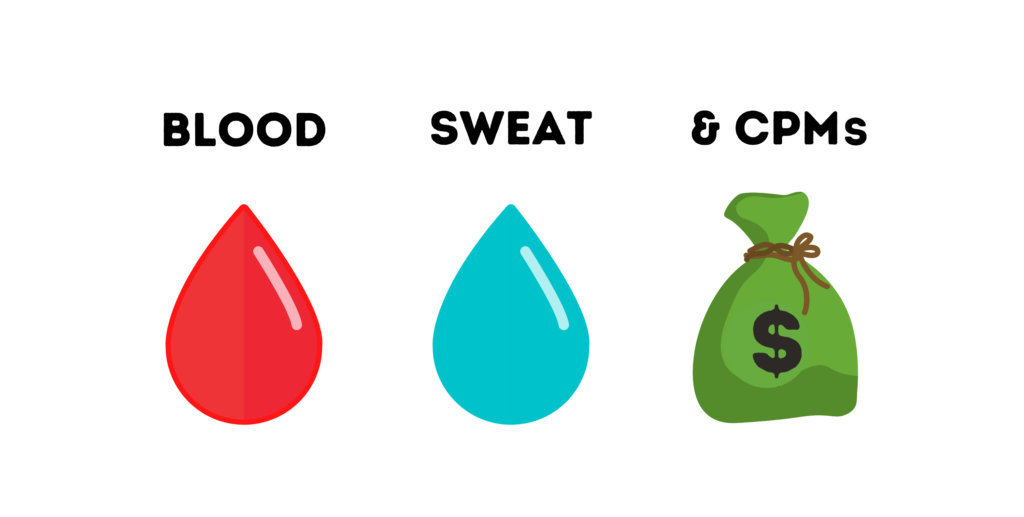
A #PublisherFirst Production
Learn more about Freestar

